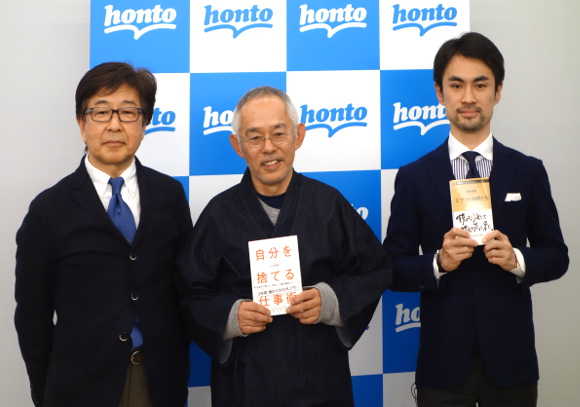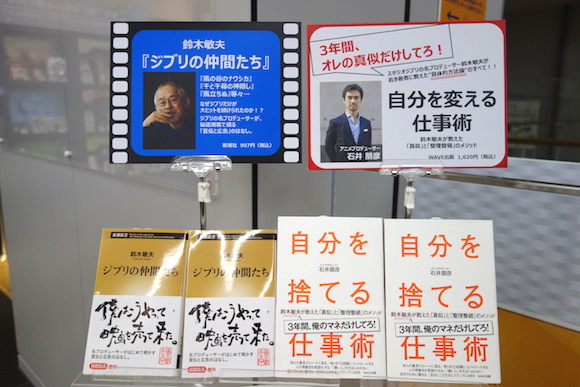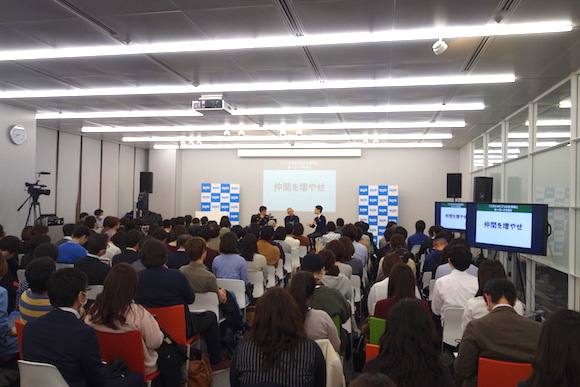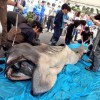
Why is Studio Ghibli located in Koganei? Why are there two girls in My Neighbour Totoro? When will Miyazaki’s next film be released? Toshio Suzuki answered all these questions and more at an event last night in Tokyo.
When you think of Studio Ghibli, a number of internationally acclaimed anime feature films come to mind: My Neighbour Totoro, Princess Mononoke and of course, Japan’s highest-ever grossing movie, Spirited Away. While many of the animation studio’s big films owe a lot to the mastery of its founding directors, Hayao Miyazaki and Isao Takahata, the fact that these films were made at all is thanks to Studio Ghibli’s co-founder and producer Toshio Suzuki. Suzuki is the man that the directors turned to for guidance when selecting new projects and the one they confided in when things became difficult, and as the driving force behind the scenes, pulling things together and bringing their works to the world, Suzuki has a lot of stories to tell about the industry. Now he’s put some of these tidbits into a new book called Ghibli no Nakamatachi, or My Ghibli Colleagues, which he spoke freely about at a book event last night, which was also attended by his esteemed junior colleague, Tomohiko Ishii.
Tomohiko Ishii has also written a book, called Jibun Wo Suteru Shigoto Jutsu, which loosely translates to The Throw Yourself Away Work Technique. As Suzuki’s long-time assistant, Ishii has worked as assistant producer on a number of Studio Ghibli films, including Howl’s Moving Castle and Spirited Away. In his new book, he shares many of the things he’s learnt while working under Suzuki at the animation studio, including the importance of colleagues and some tips for balancing the demands of work and personal life. As the one person selected to be Suzuki’s assistant from a pool of roughly 300 candidates when he was in his early 20s, the now 39 year-old recalled his joy when Suzuki told him they should relate to each other as equals, but in true Japanese kohai-senpai (junior-senior) style, Ishii deferred largely to Suzuki during the event held last night in the Ichigaya district of Tokyo.
Suzuki was his usual, charming self at the event, telling funny stories and recalling interesting moments from his working life, while the audience laughed at all his humorous anecdotes. He was also surprisingly candid during the talk, making a number of surprising revelations that had everyone at the venue, and thousands watching the broadcast as it streamed on Line Live, on the edge of their seats with excitement. Let’s take a look at some of the interesting secrets revealed by the producer below.
THE IMPORTANCE OF INCREASING YOUR CIRCLE OF COLLEAGUES
As one of the key points from Ishii’s new book, Suzuki gave an example of why colleagues, and rivals, can be important to working relationships. According to the producer, Miyazaki and Takahata enjoyed a friendly rivalry while working on their respective projects, My Neighbour Totoro and Grave of the Fireflies, before the films were released together on the same bill in 1988. Fans will know that the double-billing was born out of the need to secure funding for the release of both films, which posed a financial risk to investors. What many fans won’t know, however, is the fact that Miyazaki had a number of reservations about the release. There was a day when Miyazaki told Suzuki he would give up on Totoro, given that it was being produced alongside Grave of the Fireflies, which was a much more literary piece based on a semi-autobiographical novel written by Akiyuki Nosaka about the hardships of World War II. Miyazaki kept reminding Suzuki that his film featured “idiotic” things like a cat that’s a bus. While his concerns regarding the unusual double-billing are easy to understand, Suzuki explained that the friendly rivalry between the directors meant Miyazaki pushed for his film to be just as long as Takahata’s. Initially, only one child was set to appear in My Neighbour Totoro, so she was given a sibling in order to increase the length of the film. It’s often said that rivals help push you to be your greatest self, and Suzuki believes this was the case with the two directors.
WHY STUDIO GHIBLI WAS BUILT IN KOGANEI
Why is Studio Ghibli located in Tokyo’s Koganei neighborhood? According to Suzuki, it’s because of Miyazaki’s first crush. With the audience and Ishii himself blown away by this revelation, Suzuki recalled the story in great detail. While Studio Ghibli was first located in Tokyo’s Kichijoji district for a short time, this was an expensive area, so when they became serious about setting up the studio as it appears today, they decided to aim for an area between their home residences. With Miyazaki located in Tokorozawa in Saitama Prefecture, just north of the capital, and Suzuki located in Tokyo’s Ebisu, they searched for places in between, but slowly, things began shifting towards Tokorozawa, until they finally settled on Koganei.
▼ The rooftop area of the studio in Koganei can be viewed on Google Maps.
Anyone who’s been to the Ghibli Museum, which is located four kilometres (2.5 miles) east of the studio, will know it’s a fair way away from the centre of the city, and it seems there’s a more nostalgic, romantic reason why they decided to use this location. Decades ago, after looking at the studio’s vacant site with a local real estate agent, Miyazaki and Suzuki went for a stroll around the area until it started to get dark, and then the two found themselves suddenly standing in front of a house. With Miyazaki looking wistfully at the building, Suzuki asked him what on earth he was doing, and the director revealed that this was where his first love lived. In fact, he was rejected by her right in front of this very house. He recalled the sad moment, and his long, lonely walk to Musashi-Sakai Station afterwards, before asking Suzuki to walk with him to that very station again, which the two did. From that day on, Koganei became the home of Studio Ghibli.
RELEASE DETAILS FOR MIYAZAKI’S NEW FILM “KEMUSHI NO BORO”
Hayao Miyazaki made international news recently when it was revealed that the director wanted to increase the length of the short film he was working on, Kemushi no Boro (Boro the Hairy Caterpillar), which was being made for exclusive screening at the Ghibli Museum. According to Suzuki, who affectionately refers to Miyazaki as “Miya-san”, the feature-length project is one that the director first came up with at the same time as Princess Mononoke, with Suzuki advising Miya-san to proceed with Mononoke instead of the proposed caterpillar story at the time. After Suzuki suggested the director might like to work on bringing Kemushi no Boro to the screen during his retirement as a short film for the museum, a recent documentary which screened on national broadcaster NHK revealed that Miyazaki was now pitching it to Suzuki to become a full-length feature film, with a proposed release date of 2019. While the feature film is yet to be given the green light, it appears that Kemushi no Boro is still going ahead as a short, with Suzuki saying it’s due to be completed in the spring, which means it should be ready to be screened at the Ghibli Museum as one of their in-house shorts in July 2017.
IMPRESSIONS OF MAKOTO SHINKAI’S ANIME FILM “YOUR NAME”
Given that Makoto Shinkai’s Your Name has now surpassed all but one of Studio Ghibli’s films in terms of takings at the box office, everyone was curious to hear Suzuki’s answer when he was asked to give his impressions of the new film. According to Suzuki, Your Name’s Toho producers wanted him to view the movie before it was released, as they were very nervous about its chance of success, given it was opening in the last week of summer. Suzuki viewed it and contacted them, telling them they had nothing to worry about. He mentioned that there are lots and lots of stories out there in the world, but one of the most popular tales relates to older sisters heading out on an adventure, and returning after a number of experiences. This is the same as Miyazaki’s film, Spirited Away. Shinkai used this storyline effectively in his movie, and what impressed Suzuki was the fact that everything within the world of the film – the story, the dialogue, the music, and the dramatic characters – all really stood out in the viewing, which is rare. He also went on to say that what was interesting about the film was the fact that it could also draw on themes of loss from recent real-life events like the 2011 Tōhoku earthquake and tsunami. Suzuki finished by saying he saw a lot of Miyazaki’s influence in the movie.
SUZUKI’S FUTURE WITH MIYAZAKI
Finally, wrapping up the talk, the producer was asked whether he would be producing the full-length Kemushi no Boro feature film proposed by Miyazaki. With a laugh, he replied, “I hope I can make it until the very end”, saying that people who watched the NHK documentary will recall him remarking that Miyazaki will draw storyboards until he dies, so he’s not sure whether he’ll be alive long enough to see the film come to its completion. By deflecting the question with humour, it appears that no concrete plans for a feature film have yet been made, or if they have, they’re not ready to tell any of us about it. Given that the two still meet regularly and enjoy a solid camaraderie, we still have our fingers crossed for a future Miyazaki-Suzuki feature film release.
Given that retirement is considered to be a time when one is reborn into a second childhood in Japan, where hobbies and passions can be pursued at leisure, retirement for these two doesn’t mean they’ll stop doing what they love. Which is lucky for us, seeing as we’re not ready to live in a world without Studio Ghibli!
Story, photos © RocketNews24
Follow Oona on Twitter for more information about Studio Ghibli news from Japan.



 Hayao Miyazaki is getting worried about how his new anime is being marketed, Ghibli producer says
Hayao Miyazaki is getting worried about how his new anime is being marketed, Ghibli producer says Ghibli Park: Opening date, first photos, and a new promo video produced by Studio Ghibli!
Ghibli Park: Opening date, first photos, and a new promo video produced by Studio Ghibli! “Let’s leave it to Goro” – The moment Hayao Miyazaki was truly convinced about Ghibli theme park
“Let’s leave it to Goro” – The moment Hayao Miyazaki was truly convinced about Ghibli theme park Hayao Miyazaki Working on Proposed New Anime Feature Film
Hayao Miyazaki Working on Proposed New Anime Feature Film Ghibli reveals genre of Hayao Miyazaki’s next anime, and that it’s also working on new CG film
Ghibli reveals genre of Hayao Miyazaki’s next anime, and that it’s also working on new CG film McDonald’s new Happy Meals offer up cute and practical Sanrio lifestyle goods
McDonald’s new Happy Meals offer up cute and practical Sanrio lifestyle goods All-you-can-drink Starbucks and amazing views part of Tokyo’s new 170 meter-high sky lounge
All-you-can-drink Starbucks and amazing views part of Tokyo’s new 170 meter-high sky lounge Super Nintendo World expansion gets delayed for several months at Universal Studios Japan
Super Nintendo World expansion gets delayed for several months at Universal Studios Japan McDonald’s Japan releases a pancake pie for new retro kissaten coffeeshop series
McDonald’s Japan releases a pancake pie for new retro kissaten coffeeshop series Studio Ghibli glasses cases let anime characters keep an eye on your spectacles
Studio Ghibli glasses cases let anime characters keep an eye on your spectacles Studio Ghibli releases new action figures featuring Nausicaä of the Valley of the Wind characters
Studio Ghibli releases new action figures featuring Nausicaä of the Valley of the Wind characters Beautiful Sailor Moon manhole cover coasters being given out for free by Tokyo tourist center
Beautiful Sailor Moon manhole cover coasters being given out for free by Tokyo tourist center Is Starbucks Japan’s hot Hanami Sakura Cream better than the Frappuccino?
Is Starbucks Japan’s hot Hanami Sakura Cream better than the Frappuccino? Everything you think you know about your washlet toilet is wrong
Everything you think you know about your washlet toilet is wrong Japanese museum celebrates Golden Week by publicly dissecting rare sea creature 【Photos】
Japanese museum celebrates Golden Week by publicly dissecting rare sea creature 【Photos】 Disney princesses get official manga makeovers for Manga Princess Cafe opening in Tokyo
Disney princesses get official manga makeovers for Manga Princess Cafe opening in Tokyo More foreign tourists than ever before in history visited Japan last month
More foreign tourists than ever before in history visited Japan last month Starbucks reopens at Shibuya Scramble Crossing with new look and design concept
Starbucks reopens at Shibuya Scramble Crossing with new look and design concept Beautiful new Final Fantasy T-shirt collection on the way from Uniqlo【Photos】
Beautiful new Final Fantasy T-shirt collection on the way from Uniqlo【Photos】 Is the new Shinkansen Train Desk ticket worth it?
Is the new Shinkansen Train Desk ticket worth it? Foreign English teachers in Japan pick their favorite Japanese-language phrases【Survey】
Foreign English teachers in Japan pick their favorite Japanese-language phrases【Survey】 Japanese convenience store packs a whole bento into an onigiri rice ball
Japanese convenience store packs a whole bento into an onigiri rice ball We try out “Chan Ramen”, an underground type of ramen popular in the ramen community
We try out “Chan Ramen”, an underground type of ramen popular in the ramen community Studio Ghibli releases Kiki’s Delivery Service chocolate cake pouches in Japan
Studio Ghibli releases Kiki’s Delivery Service chocolate cake pouches in Japan Japan’s bone-breaking and record-breaking roller coaster is permanently shutting down
Japan’s bone-breaking and record-breaking roller coaster is permanently shutting down New definition of “Japanese whiskey” goes into effect to prevent fakes from fooling overseas buyers
New definition of “Japanese whiskey” goes into effect to prevent fakes from fooling overseas buyers Our Japanese reporter visits Costco in the U.S., finds super American and very Japanese things
Our Japanese reporter visits Costco in the U.S., finds super American and very Japanese things Studio Ghibli unveils Mother’s Day gift set that captures the love in My Neighbour Totoro
Studio Ghibli unveils Mother’s Day gift set that captures the love in My Neighbour Totoro Foreign passenger shoves conductor on one of the last full runs for Japan’s Thunderbird train
Foreign passenger shoves conductor on one of the last full runs for Japan’s Thunderbird train Domino’s Japan now sells…pizza ears?
Domino’s Japan now sells…pizza ears? New Japanese KitKat flavour stars Sanrio characters, including Hello Kitty
New Japanese KitKat flavour stars Sanrio characters, including Hello Kitty Kyoto creates new for-tourist buses to address overtourism with higher prices, faster rides
Kyoto creates new for-tourist buses to address overtourism with higher prices, faster rides Sales of Japan’s most convenient train ticket/shopping payment cards suspended indefinitely
Sales of Japan’s most convenient train ticket/shopping payment cards suspended indefinitely Sold-out Studio Ghibli desktop humidifiers are back so Totoro can help you through the dry season
Sold-out Studio Ghibli desktop humidifiers are back so Totoro can help you through the dry season Japanese government to make first change to romanization spelling rules since the 1950s
Japanese government to make first change to romanization spelling rules since the 1950s Ghibli founders Toshio Suzuki and Hayao Miyazaki contribute to Japanese whisky Totoro label design
Ghibli founders Toshio Suzuki and Hayao Miyazaki contribute to Japanese whisky Totoro label design Doraemon found buried at sea as scene from 1993 anime becomes real life【Photos】
Doraemon found buried at sea as scene from 1993 anime becomes real life【Photos】 Tokyo’s most famous Starbucks is closed
Tokyo’s most famous Starbucks is closed One Piece characters’ nationalities revealed, but fans have mixed opinions
One Piece characters’ nationalities revealed, but fans have mixed opinions We asked a Uniqlo employee what four things we should buy and their suggestions didn’t disappoint
We asked a Uniqlo employee what four things we should buy and their suggestions didn’t disappoint Princesses, fruits, and blacksmiths: Study reveals the 30 most unusual family names in Japan
Princesses, fruits, and blacksmiths: Study reveals the 30 most unusual family names in Japan Hayao Miyazaki spends retirement from anime by…spending every day at his animation studio
Hayao Miyazaki spends retirement from anime by…spending every day at his animation studio The Place Where Totoro Was Born: New Studio Ghibli book includes art by Hayao Miyazaki’s wife
The Place Where Totoro Was Born: New Studio Ghibli book includes art by Hayao Miyazaki’s wife Studio Ghibli co-founder Toshio Suzuki receives lifetime achievement honor at Annie awards
Studio Ghibli co-founder Toshio Suzuki receives lifetime achievement honor at Annie awards Evangelion creator Hideaki Anno wants to make a live-action Nausicaä of the Valley of the Wind
Evangelion creator Hideaki Anno wants to make a live-action Nausicaä of the Valley of the Wind Beardless Hayao Miyazaki has on-brand answer to what he likes about The Boy and the Heron【Video】
Beardless Hayao Miyazaki has on-brand answer to what he likes about The Boy and the Heron【Video】 Totoro beer? Hayao Miyazaki draws new version of anime icon for Japanese craft beer label
Totoro beer? Hayao Miyazaki draws new version of anime icon for Japanese craft beer label Producer clarifies Studio Ghibli’s future, mentions that Miyazaki “would like to make an anime”
Producer clarifies Studio Ghibli’s future, mentions that Miyazaki “would like to make an anime” Ghibli’s The Boy and the Heron won a Golden Globe. Now can it win an Oscar?
Ghibli’s The Boy and the Heron won a Golden Globe. Now can it win an Oscar? Ghibli’s Boy and the Heron wins Academy Award, studio COO apologizes for Hayao Miyazaki’s absence
Ghibli’s Boy and the Heron wins Academy Award, studio COO apologizes for Hayao Miyazaki’s absence Hayao Miyazaki considers Demon Slayer his rival, Studio Ghibli producer says
Hayao Miyazaki considers Demon Slayer his rival, Studio Ghibli producer says Studio Ghibli offers special Spirited Away present with Toshio Suzuki exhibition tickets in Tokyo
Studio Ghibli offers special Spirited Away present with Toshio Suzuki exhibition tickets in Tokyo Hayao Miyazaki makes rare video appearance to check out Ghibli Museum’s revamped cafe【Video】
Hayao Miyazaki makes rare video appearance to check out Ghibli Museum’s revamped cafe【Video】 Studio Ghibli co-founder and anime director Isao Takahata passes away in Tokyo
Studio Ghibli co-founder and anime director Isao Takahata passes away in Tokyo Hayao Miyazaki’s Nausicaä of the Valley of the Wind set to become live-action Japanese kabuki play
Hayao Miyazaki’s Nausicaä of the Valley of the Wind set to become live-action Japanese kabuki play
Leave a Reply